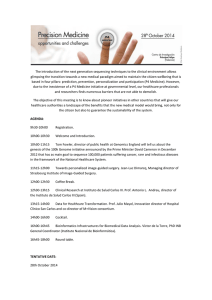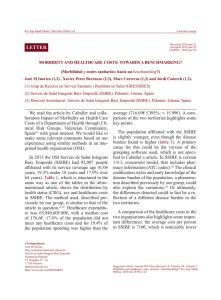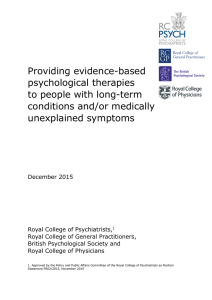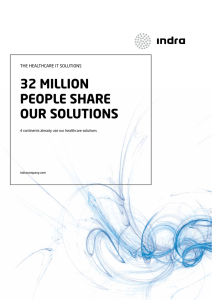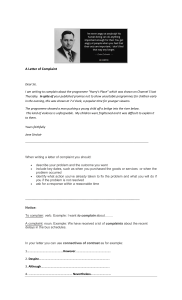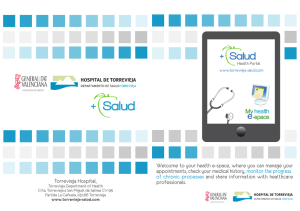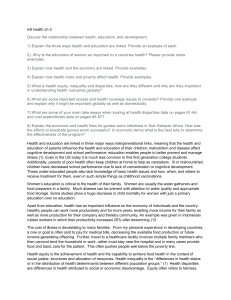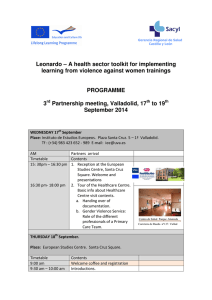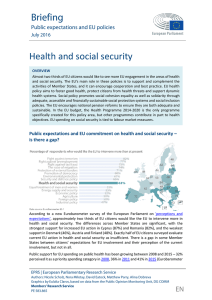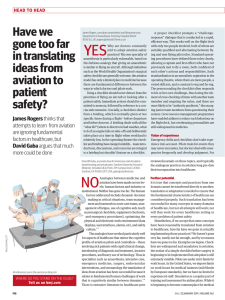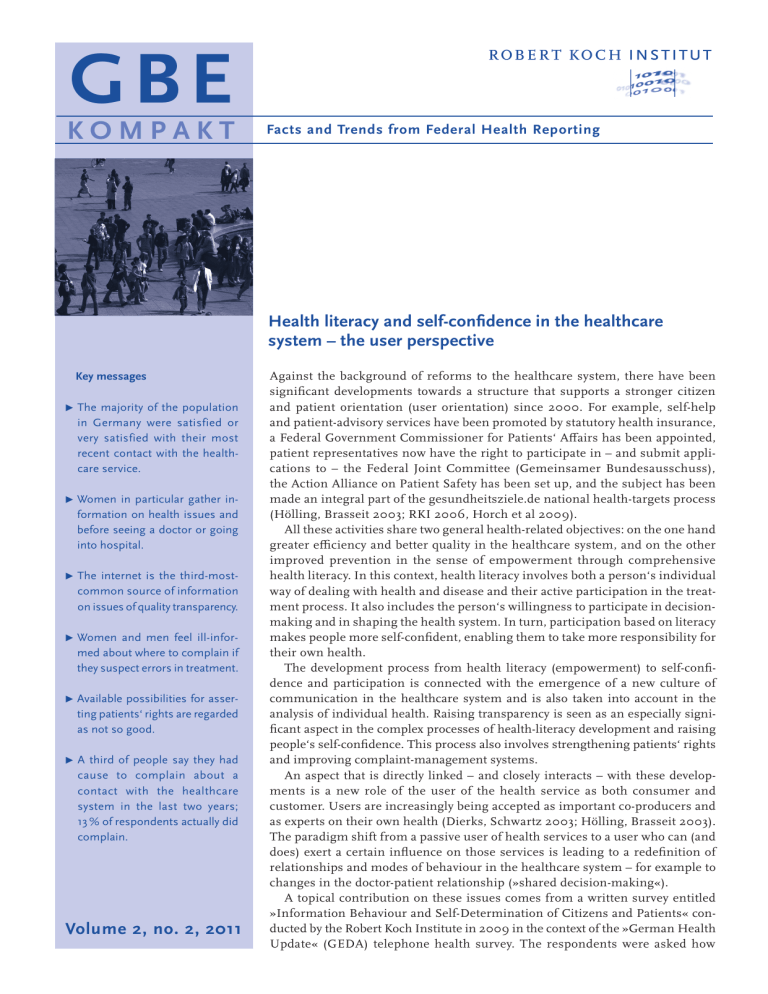
GB E KOMPAKT Facts and Trends from Federal Health Reporting Health literacy and self-confidence in the healthcare system – the user perspective Key messages ▶ The majority of the population in Germany were satisfied or very satisfied with their most recent contact with the healthcare service. ▶ Women in particular gather in- formation on health issues and before seeing a doctor or going into hospital. ▶ The internet is the third-most- common source of information on issues of quality transparency. ▶ Women and men feel ill-infor- med about where to complain if they suspect errors in treatment. ▶ Available possibilities for asser- ting patients‘ rights are regarded as not so good. ▶ A third of people say they had cause to complain about a contact with the healthcare system in the last two years; 13 % of respondents actually did complain. Volume 2, no. 2, 2011 Against the background of reforms to the healthcare system, there have been significant developments towards a structure that supports a stronger citizen and patient orientation (user orientation) since 2000. For example, self-help and patient-advisory services have been promoted by statutory health insurance, a Federal Government Commissioner for Patients‘ Affairs has been appointed, patient representatives now have the right to participate in – and submit applications to – the Federal Joint Committee (Gemeinsamer Bundesausschuss), the Action Alliance on Patient Safety has been set up, and the subject has been made an integral part of the gesundheitsziele.de national health-targets process (Hölling, Brasseit 2003; RKI 2006, Horch et al 2009). All these activities share two general health-related objectives: on the one hand greater efficiency and better quality in the healthcare system, and on the other improved prevention in the sense of empowerment through comprehensive health literacy. In this context, health literacy involves both a person‘s individual way of dealing with health and disease and their active participation in the treatment process. It also includes the person‘s willingness to participate in decisionmaking and in shaping the health system. In turn, participation based on literacy makes people more self-confident, enabling them to take more responsibility for their own health. The development process from health literacy (empowerment) to self-confidence and participation is connected with the emergence of a new culture of communication in the healthcare system and is also taken into account in the analysis of individual health. Raising transparency is seen as an especially significant aspect in the complex processes of health-literacy development and raising people‘s self-confidence. This process also involves strengthening patients‘ rights and improving complaint-management systems. An aspect that is directly linked – and closely interacts – with these developments is a new role of the user of the health service as both consumer and customer. Users are increasingly being accepted as important co-producers and as experts on their own health (Dierks, Schwartz 2003; Hölling, Brasseit 2003). The paradigm shift from a passive user of health services to a user who can (and does) exert a certain influence on those services is leading to a redefinition of relationships and modes of behaviour in the healthcare system – for example to changes in the doctor-patient relationship (»shared decision-making«). A topical contribution on these issues comes from a written survey entitled »Information Behaviour and Self-Determination of Citizens and Patients« conducted by the Robert Koch Institute in 2009 in the context of the »German Health Update« (GEDA) telephone health survey. The respondents were asked how 2 GBE kompakt - Vol. 2, no. 2, 2011 satisfied they were in their contacts with the healthcare system, how they obtained information on health-related issues, how much they knew about various health- and system-relevant subjects, what activities they engaged in, and what possible ways they saw of exerting an influence. The data were initially examined to determine whether parameters of health literacy, attitude, action and satisfaction differed according to socio-demographic and socioeconomic criteria. The following selected results provide an initial descriptive overview. Table 1 Satisfaction with most recent contact with the healthcare In percent Data basis: Additional 2009 GEDA survey Response rate: Survey period: not at all satisfied 26.2 61.5 11.1 1.2 Women 26.7 59.9 11.4 2.0 Men 25.9 63.0 10.7 0.4 1.3 Age groups*** 18 – 39 years 26.9 57.7 14.1 40 – 59 years 25.7 62.4 10.0 1.9 60 years + 26.1 65.4 8.2 0.3 Social status*** Robert Koch Institute To provide up-to-date data on healthcare users‘ satisfaction level, information behaviour and possible ways to influence the system Postal Survey Residential population of Germany aged 18 and over 5,296 women and men: only participants in the GEDA 2009 survey who had agreed to take part in a further survey 57.3 % January to March 2009 Sample: not very satisfied Total Additional GEDA survey Survey method: Population: satisfied Sex** »Information Behaviour and Self-determination of Citizens and Patients« Data holder: Objectives: very satisfied Low 18.4 59.9 19.0 2.7 Middle 28.0 60.6 10.4 1.0 High 27.6 63.8 7.8 0.8 Statutory 24.3 62.2 12.2 1.3 Private 36.8 57.3 5.3 0.6 Health insurance*** *p< 0.05; **p< 0.01; ***p< 0.001 General satisfaction with the healthcare system contacts Surveys on user satisfaction provide information on how the population perceive and assess the medical treatment provided by the healthcare system and on the extent to which they have confidence in it (e. g. Bestmann, Verheyen 2010; Koch et al 2010). The data from the additional survey show a very high level of satisfaction with people‘s most recent contact with the healthcare system, e. g. with their family doctor (Table 1). The majority of the respondents were »very satisfied« or »satisfied« (88 % altogether). The men were significantly more satisfied than the women; as regards the different age groups, older people were more satisfied. People with private health insurance reported higher satisfaction rates than those with statutory health insurance. The analysis according to social status – which took variables such as education, income and career status into account – showed that people with middle or high social status were more satisfied than people in the low social-status group. Looking at satisfaction with most recent contact in a more differentiated fashion – from the perspectives of information received, time available for talking, human warmth and treatment outcome – some differences came to light despite a high overall level of satisfaction in this field. The main aspects classified as unsatisfactory were the amount of time available for talking, which was criticized by 17 % (19 % of women, 16 % of men), and the result of treatment by 16 % (15 % of women, 16 % of men) (see Figure 1). Figure 1 Satisfaction with the last contact with the healthcare system Data basis: Additional 2009 GEDA survey Information Time available for talking Human warmth Treatment outcome 0 10 20 very satisfied 30 40 satisfied 50 60 not very satisfied 70 80 90 not at all satisfied 100 Percent 3 Vol. 2, no. 2, 2011 – GBE kompakt People want more information Transparency and being well-informed are regarded as crucial for strengthening the users‘ position as partners in the healthcare system, both in their choice of health services and in their taking a degree of responsibility for regaining and maintaining their own health (Horch, Wirz 2005). As previous studies have shown, the population are highly interested in health information in general. According to a study conducted by the Bertelsmann Foundation as part of the annual Health Monitor scheme, four out of five adults look for information about health and diseases out of their own interest (Bertelsmann Stiftung 2004). The data from RKI‘s 2003 Telephone Health Survey (GSTel03) showed that the population were very interested in health-related topics: only 2 % of the respondents (2.5 % of the men, 1.5 % of the women) did not use any of the specified information sources (Horch, Wirz 2005). According to data from the additional 2009 GEDA survey, 28 % of people specifically gathered information from an institution of their choice before seeing a doctor or going into hospital (Table 2). Women obtained information slightly more frequently than men in this context. More people in the older age groups tended to look for information in the run-up to a medical contact. Differences also appeared with rising social status: people with a higher social status were more likely to search for information than those with a low status. People obtain information from different sources before seeing a doctor or going into hospital. Both women and men obtain information most frequently in their social environment, i.e. from family and friends or from other physicians (Figure 2). This has been confirmed by data from the Bertelsmann Foundation‘s Health Monitor Table 2 Search for information before seeing a doctor In percent Data basis: Additional 2009 GEDA survey Previous information search Total 28.2 Sex** Women 30.5 Men 25.7 Age groups*** 18 – 39 years 26.1 40 – 59 years 29.9 60 years + 28.2 Social status*** Low 22.5 Middle 27.9 High 33.7 Health insurance*** Statutory 27.5 Private 31.3 *p< 0,05; **p< 0,01; ***p< 0,001 (Marstedt 2007; Bertelsmann Stiftung 2007). The data from the GEDA additional survey showed that the internet was the second most commonly used source of information, especially among people aged between 18 and 39. People with a high social status used the internet as a source of information much more often than people with a low and middle social status. Figure 2 Sources of information before seeing a doctor or going into hospital Data basis: Additional 2009 GEDA survey Other doctor Family members/friends Internet Health insurance Doctors/hospital guide List of doctors Chamber of physicians Women Advice centre Men 0 10 20 30 40 50 60 Percent People would often like to have more information about various areas of the healthcare system. Areas in which a majority of people felt ill-informed included where to report suspected errors in treatment (88 %), the quality of old people‘s and nursing homes (83 %), mobile nursing services (81 %), and cost aspects (78 %). There were no significant differences between the genders. A large group of people (73 %), including more younger than older people, also expressed a desire for more information on their rights as patients. In terms of social status, it became clear that people with a higher social status felt less well informed in some areas. This was especially evident in relation to the quality of care facilities (Table 3). Perhaps this result suggests that different social-status groups have different ideas on what to expect from healthcare facilities. The results also showed that very few people knew which departments or offices in the healthcare system represented patients‘ interests. For example, only 14 % (12 % of women, 17 % of men) had heard of the Federal Government‘s Commissioner for Patients‘ Affairs (www.patientenbeauftragter.de), a post that was introduced with the Statutory Health-Insurance Modernization Act on 1 January 2004. This percentage rose with age and social status. 4 GBE kompakt - Vol. 2, no. 2, 2011 Possibilities for asserting patients‘ rights were rated »not so good« Table 3 Areas of the healthcare system in which respondents feel ill-informed, by social statu In percent Data basis: Additional 2009 GEDA survey Individual patients‘ rights were better known, however. Respondents were queried about nine specific rights; the best known of these were the free choice of medical practitioner and the right to confidential treatment of personal data (Figure 3). The least well known rights in the population were the right to self-determination, damages, access to documents, treatment with due care, and advice by the patient‘s health insurance fund. Fewer than 50 % knew about these rights. In the 60+ age group only 34 % knew about the right to damages; the 18- to 39-year-olds were the least familiar with the right to advice from their healthinsurance provider (41 %). All nine patients‘ rights were less well known among people with a low social status than among members of higher status groups. The respondents were also asked to rate their opportunities to assert their rights as patients in Germany. About 36 % considered these possibilities to be good or very good (Table 4). Nearly half judged their chances to be as »not so good«, and about 16 % rated them as bad to very bad. Social status Low Middle High Rights as a patient** 67.0 74.9 70.9 Ways of preventing diseases*** 44.2 39.0 29.8 Treatment alternatives* 62.5 67.4 61.2 Where to report suspected errors in treatment*** 81.1 89.3 89.2 Quality of doctors** 65.6 65.5 72.9 Quality of hospitals* 60.9 65.7 69.6 Quality of old peoples‘ and nursing homes*** 75.6 85.0 84.0 Quality of mobile nursing services*** 74.9 81.2 87.1 Costs of medical treatment*** 75.7 81.3 66.1 Changes in the way health insurance companies pay for health services*** 74.7 79.7 72.3 Patients‘ contributions to the cost of drugs*** 65.4 71.0 60.3 *p< 0.05; **p< 0.01; ***p< 0.001 Since 2004 patient representatives have been working in an advisory capacity in decision-making bodies of the German healthcare system. Here again, only a small proportion of the population knew about this function (6 %): 7 % of the women and 5 % of the men were aware of this legal recourse. Only 4 % of women and 2 % of men (3 % overall) knew the brochure ‚Patients‘ Rights in Germany‘ (www.bundesgesundheitsministerium.de). There were no significant differences here according to age or social status. People have cause to complain, but rarely do so Being aware of what people complain about is regarded as a valuable resource. It helps to optimize processes, improve patient and user satisfaction, and identify risks. In the survey, 37 % of the women and 28 % of the men said they would have liked to complain about a contact in the healthcare system over the past two years (Figure 4). This applies especially to people aged between 18 and 39. Figure 3 Awareness of patients‘ rights Data basis: Additional 2009 GEDA survey Free choice of medical practitioner Confidential treatment of data Second opinion Comprehensive information Advice from health insurance fund Access to documents Treatment with due care Self-determination Women Damages Men 0 10 20 30 40 50 60 70 80 90 100 Percent 5 Vol. 2, no. 2, 2011 – GBE kompakt There were no significant differences after stratification according to social status. Seen from the point of view of health-insurance status, privately insured people less frequently had cause to complain. Overall, 13 % of the people actually did complain: 14 % of the women and 12 % of the men (Figure 4). Figure 4 Cause for complaint on contact with the healthcare system over the past two years Data basis: Additional 2009 GEDA survey 100 Percent 90 80 70 Table 4 Assessment of possibilities for asserting patients‘ rights In percent Data basis: Additional 2009 GEDA survey 60 50 40 Assessment Very good Good weniger good Bad 2.2 33.9 48.2 Women Men 2.2 33.6 2.2 34.1 18 – 39 years 1.5 40 – 59 years 1.9 60 years + 30 Very bad 20 12.6 3.1 10 49.7 12.0 2.5 46.6 13.4 3.7 36.9 46.6 12.3 2.5 28.0 52.9 13.2 4.0 3.4 37.6 44.3 12.1 2.6 Low 3.1 33.6 47.5 12.3 3.5 Middle 2.2 32.2 49.8 12.8 3.0 High 2.0 40.4 43.7 11.3 2.6 Statutory 2.2 34.1 47.4 13.4 2.9 Private 3.0 36.1 49.0 7.4 4.5 Total No cause for complaint Cause for complaint; did not complain Cause for complaint; did complain Sex Total Women Men Age groups*** Social status Health insurance*** *p< 0.05; **p< 0.01; ***p< 0.001 The respondents were also asked about the specific cause for complaint. Most frequently cited were general practitioners (44 %) and hospitals (26 %) (see Figure 5). Gender differences were especially evident in the case of complaints to hospitals (29 % of women, 21 % of men) and health insurance funds (18 % of women, 25 % of men). Conclusion The analysis of the data from the additional 2009 GEDA survey on »Information Behaviour and Self-determination of Citizens and Patients« reveals that the population lacks knowledge not only on certain areas of the healthcare system, but also on patients‘ rights, how to assert these rights, and how to complain. It emerges that different population groups have different needs, and this information can be used to improve target-group orientation when it comes to knowledge transfer and developing health literacy. Gender, age and social status prove to be relevant impacting factors in this context, and a differentiated picture emerges for different sub-groups, indicating ways of improving how information and communication services are geared to the needs of different interest groups. Overall, there are evidently considerable information gaps on issues relating to quality and cost transparency and on where to seek support when errors of treatment are suspected. Similarly, the majority feel they are poorly informed on their patients‘ rights and are not sure how best to assert them. The results show that more differentiated and versatile support services are needed in order to offer healthcare users the kind of development opportunities that might enable them to become health-literate partners, empowering them to play a role not only as »payers« but also as »players« in the healthcare system. In particular, people in the low social-status group seem to require such forms of support. They look for information less frequently, are less aware of their rights, and are also the least satisfied. Gender differences become particularly evident when it comes to searching for information. Women are more active than men in this context. On the other hand, Figure 5 Where there was cause for complaint Data basis: Additional 2009 GEDA survey General practitioner Hospital Health insurance fund Pension insurance Women Other Men 0 10 20 30 40 50 Percent 6 GBE kompakt - Vol. 2, no. 2, 2011 they are less aware of their rights as patients. The abovementioned overall conditions in the healthcare system and their further development represent an essential foundation on which health literacy can be strengthened among patients/users. At the same time, development conditions are relevant in social contexts, for example in the family, school and workplace. This also applies to areas outside the health sector, such as education and social services, which can provide knowledge that can raise literacy. These results represent a contribution both to publichealth science – particularly in terms of research into health literacy and prevention – and to health-services research, which aims at a more patient-focused orientation when it comes to improving the quality of healthcare. Bibliography Bertelsmann Stiftung (Hrsg) (2006) Bedarf an Patienteninformationen über das Krankenhaus – Eine Literaturanalyse erstellt von Prof. Dr. Doris Schaeffer. Bertelsmann Stiftung, Gütersloh http://www.bertelsmann-stiftung.de (last revised: 07.04.2011) Bestmann B, Verheyen F (2010) Patientenzufriedenheit. Ergebnisse einer repräsentativen Studie in der ambulanten ärztlichen Versorgung. Techniker Krankenkasse (Hrsg) WINEG Wissen 01. Techniker Krankenkasse (Hrsg), Hamburg Böcken J, Braun B, Schnee M (Hrsg) (2004) Gesundheitsmonitor 2004. Die ambulante Versorgung aus Sicht von Bevölkerung und Ärzteschaft. Verlag Bertelsmann Stiftung. Gütersloh http://www.bertelsmann-stiftung.de (last revised: 07.04.2011) Dierks ML, Schwartz FW (2003) Patienten, Versicherte, Bürger- die Nutzer des Gesundheitswesens. In: Badura et al. (Hrsg) Public Health. Gesundheit und Gesundheitswesen. Urban & Fischer. München, Dr. Kerstin Horch¹, Dr. Livia Ryl¹, Dr. Birte Hintzpeter¹, Prof. Dr. Marie-Luise Dierks² ¹Robert Koch Institute Department of Epidemiology and Health Reporting and ² Hannover Medical School Institute for Epidemiology, Social Medicine and Health Systems Research Jena. S 314–321 Hölling G, Brasseit U (2003) Gesundheitsziele zur Stärkung der gesundheitlichen Kompetenz von Bürgern und Patienten. Bundesgesundheitsbl – Gesundheitsforsch – Gesundheitsschutz 45(2): 128–133 Horch K, Wirz J (2005) Nutzung von Gesundheitsinformationen. Bundesgesundheitsbl – Gesundheitsforsch – Gesundheitsschutz 48(11): 1250–1255 Horch K, Hölling G, Klärs G et al. (2009) Ansätze zur Evaluation des Gesundheitsziels »Gesundheitliche Kompetenz erhöhen, Patient(inn)ensouveränität stärken«. Bundesgesundheitsbl – Gesundheitsforsch – Gesundheitsschutz 52 (10): 889–896 Koch K, Schürmann C, Sawicki P (2010) Das deutsche Gesundheitswesen im internationalen Vergleich. Die Perspektive der Patienten. Deutsches Ärzteblatt 107(24): 427–434 Marstedt G (2007) Transparenz in der ambulanten Versorgung: Patienten auf der Suche nach einem »guten Arzt«. In: Böcken J, Braun B, Amhof R (Hrsg) Gesundheitsmonitor 2007. Gesundheitsversorgung und Gestaltungsoptionen aus der Perspektive von Bevölkerung und Ärzten. Verlag Bertelsmann Stiftung, Gütersloh Robert Koch-Institut (2006) Bürger- und Patientenorientierung im Gesundheitswesen. Gesundheitsberichterstattung des Bundes. Heft 32. RKI, Berlin http://www.rki.de/gbe (last revised: 07.04.2011) Vol. 2, no. 2, 2011 – GBE kompakt 7 GBE kompakt Published by Robert Koch Institute Nordufer 20 13353 Berlin Editorial staff Dr. Christine Hagen, Dr. Livia Ryl Robert Koch Institute Department of Epidemiology and Health Reporting General-Pape-Straße 62 12101 Berlin Tel.: 030-18 754-3400 Email: gbe@rki.de www.rki.de/gbe How to quote the title Horch K, Ryl L, Hintzpeter B, Dierks ML (2011) Health literacy and self-confidence in the healthcare system – the user perspective. Published by Robert Koch Institute Berlin, GBE kompakt 2(2) www.rki.de/gbe-kompakt (last revised: 07.04.2011) ISSN 2191-4974 The Robert Koch Institute is a federal institute within the portfolio of the Federal Ministry of Health
